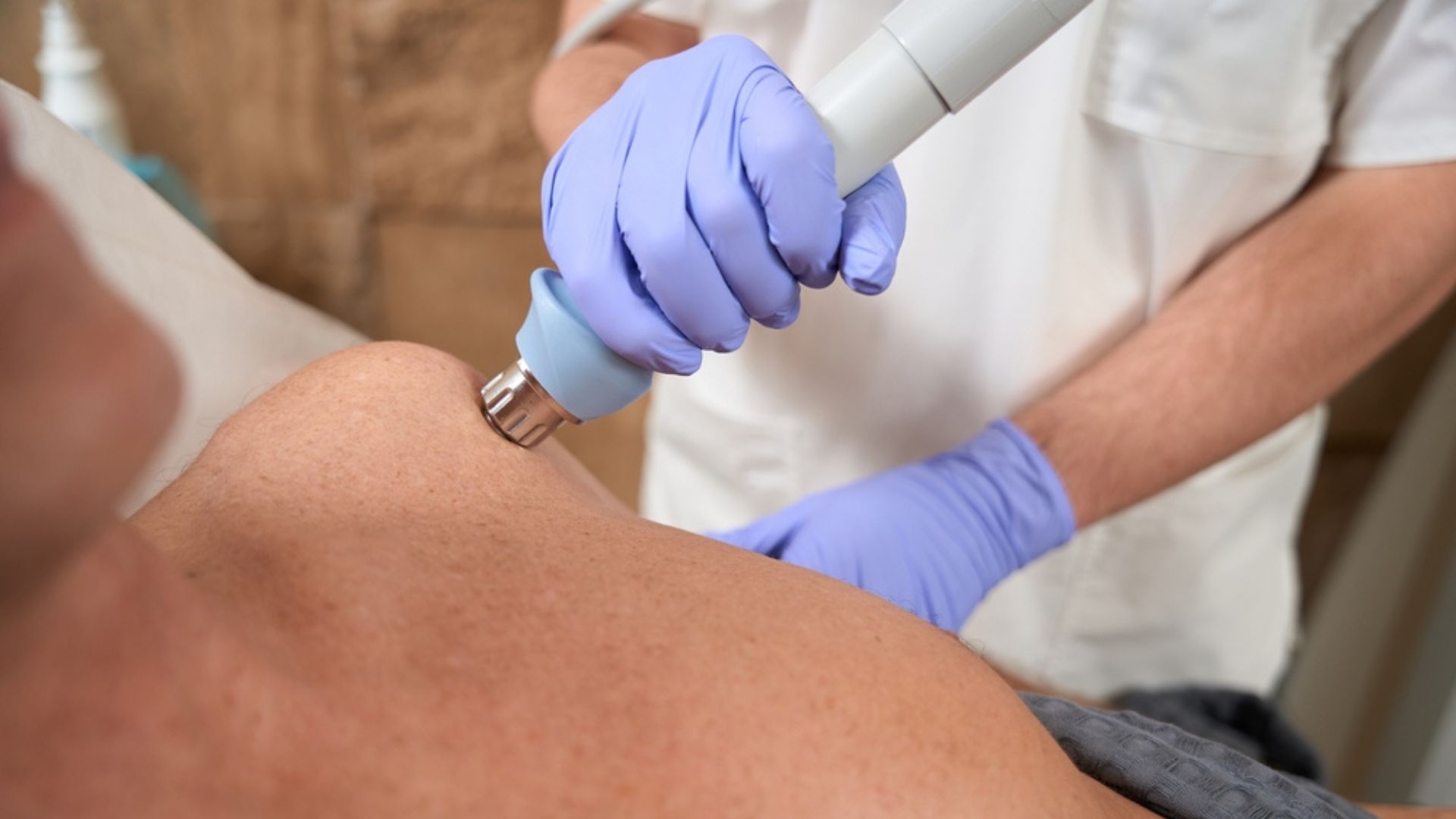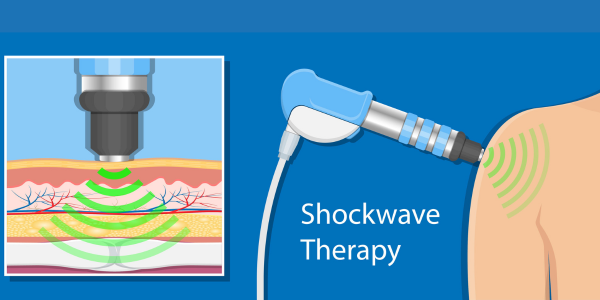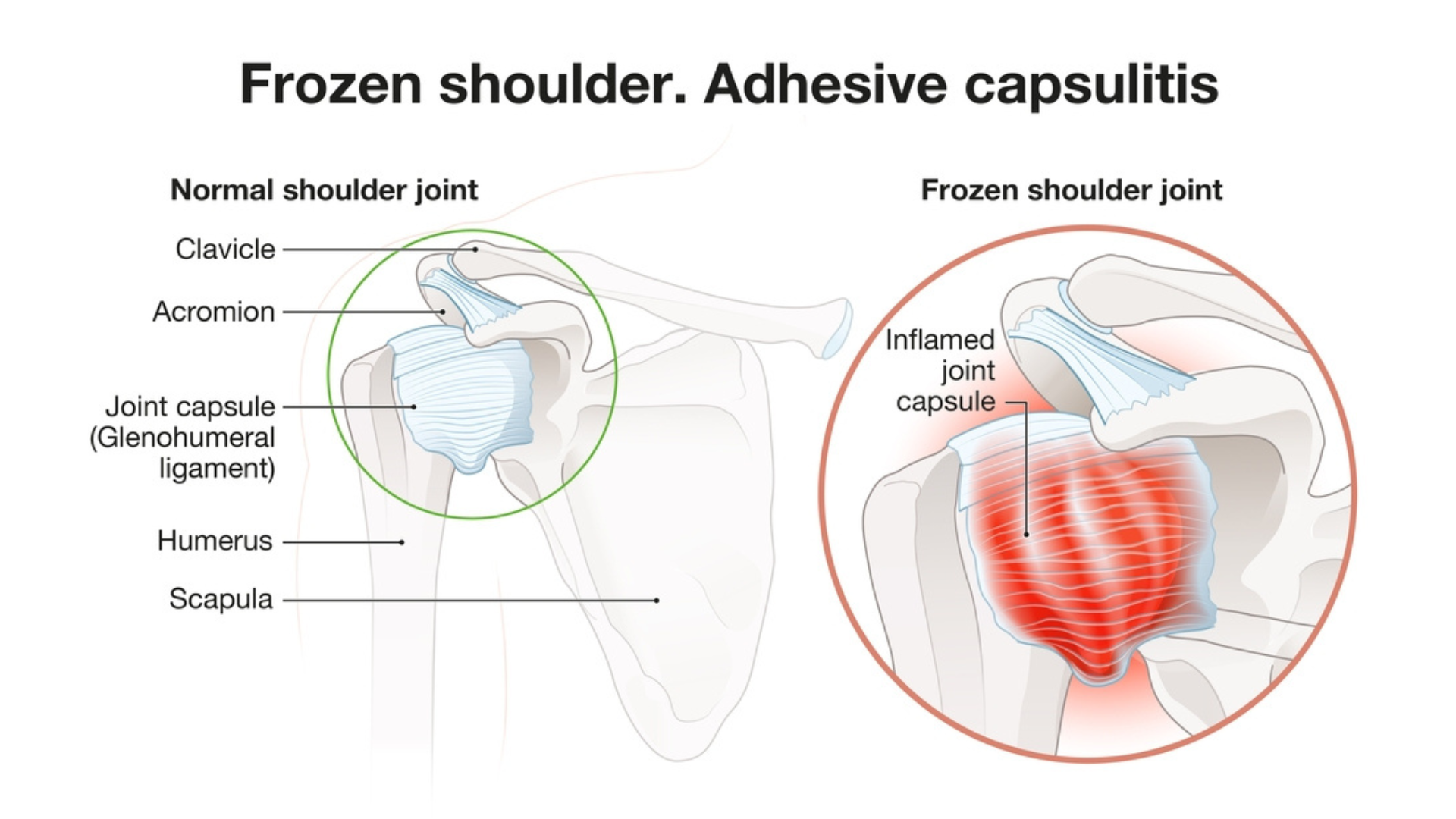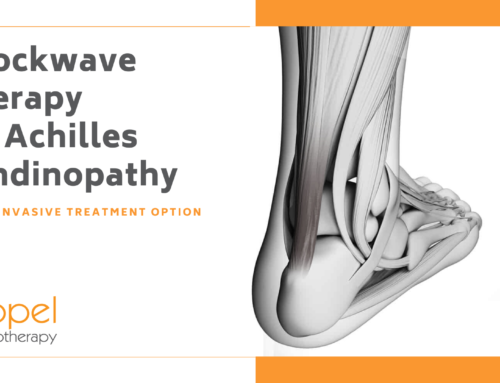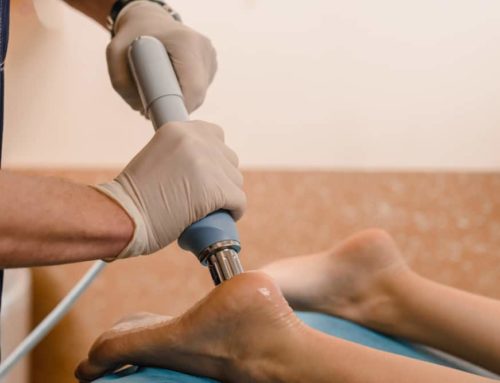Frozen shoulder (also called adhesive capsulitis) causes pain and stiffness in the shoulder area, which can make it difficult to move. Shockwave therapy for frozen shoulder is one treatment option that a registered physiotherapist might suggest, along with other strategies, to help you return to a more normal and pain-free lifestyle.
In this article, we examine how shockwave therapy works, the different categories of frozen shoulder, risk factors, symptoms and progressions, as well as various treatment options, including shockwave therapy for frozen shoulder.
Table of Contents:
- What is shockwave therapy?
- What is frozen shoulder?
- Risk factors for secondary frozen shoulder
- Symptoms and progression of frozen shoulder
- Shockwave therapy for frozen shoulder treatment
- Other treatment options for frozen shoulder
- Conclusion
What is Shockwave Therapy?
Shockwave therapy is a non-invasive modality that is used to treat several common musculoskeletal conditions. There are two types of shockwave therapy, focused and radial shockwave therapy.
Focused shockwaves also known as hard shocks can reach tissues that are deeper in our body. Radial shockwaves are also known as soft shocks can reach tissues that are more superficial like ligaments, tendons, and muscles. Radial shockwaves are more commonly found in clinics and is what we use at Propel Physiotherapy.
Shockwaves are a form of acoustic energy, which gets transmitted to our body’s tissues by an applicator and a gel medium. These shockwaves are thought to create changes in pressure, and trigger responses in the body that facilitate the natural healing response.
Shockwave is thought to facilitate biochemical reactions and trigger the release of biomolecules that facilitate the formation of new blood vessels, stimulation of collagen and protein production, release of substance P (which is thought to help facilitate pain reduction), and trigger biological responses that contribute to bone healing.[i]
Some common conditions that shockwave therapy is used for includes Achilles tendinopathy, patellar tendinopathy (jumper’s knee), plantar fasciitis, lateral epicondylitis (tennis elbow), calcific tendonitis, and frozen shoulder (adhesive capsulitis).
What is Frozen Shoulder?
Frozen shoulder, also known as adhesive capsulitis, is an inflammatory condition that causes adhesions in the glenohumeral joint (shoulder), which results in progressively increasing pain and reduced range of motion.
Frozen shoulder can be categorized into two types:
Primary (idiopathic) frozen shoulder is when there is an increase in pain and a loss of range of motion without a known cause.
Secondary frozen shoulder is when the condition occurs due to a known cause or event, like an injury or a surgical operation.
Risk Factors for Secondary Frozen Shoulder
Secondary frozen shoulder can also be the result of different predisposing factors:[ii]
- Systemic Factors: Diabetes mellitus, thyroid dysfunctions, hypoadrenalism
- Intrinsic Factors: Rotator cuff pathologies, biceps tendinopathy, calcific tendinitis, and acromioclavicular arthritis
- Extrinsic Factors: Cardiopulmonary diseases, cervical disc disease, stroke, Parkinson’s, and humeral fractures
- Sex: Females are more likely to be affected than males
- Age: The condition is more prevalent in the 40-70 age group
Symptoms and Progression of Frozen shoulder
Frozen shoulder a “self-limiting” condition, which means that it typically resolves on its own with time. It can be classified into three overlapping stages:2
- Stage 1 – Freezing
- Gradually worsening pain, at end ranges of movement and even at rest, that may affect your sleep.
- Gradually decreased range of motion, where movements are especially limited in external rotation, abduction, and internal rotation.
- This stage can last between 3-9 months.
- Stage 2 – Frozen
- Pain begins to subside, but range of motion is still restricted.
- This stage can last between 9-12 months.
- Stage 3 – Thawing
- Pain reduces further with progressive improvements in range of motion.
- In some individuals, this stage can last between 12-24 months.
You may also enjoy reading: Shockwave Therapy for Plantar Fasciitis
Shockwave Therapy for Frozen Shoulder Treatment
Shockwave therapy has been suggested as a safe and effective non-invasive form of therapy for individuals who are dealing with frozen shoulder. A research study conducted by Hussein and Donatelli in 2015 demonstrated that shockwave therapy was a safe treatment for frozen shoulder.
The study utilized a combination of shockwave therapy and exercise and found that the combination resulted in significant improvements in function and range of motion, and significant reductions in patient-reported pain.[iii]
Other studies have compared the use of shockwave therapy to steroid therapy. The study conducted by Chen et al. in 2014 suggested that shockwave therapy can be used as an alternative to steroid therapy as it resulted in greater short-term improvements in range of motion and the ability to perform activities of daily living.[iv]
The comparison was also studied in a diabetic population by Santoboni et al. in 2017, who demonstrated that shockwave therapy resulted in greater improvements in pain and shoulder function than steroid therapy.[v]
These studies are important to note as steroids can significantly increase glucose levels, which make glucose control difficult for patients with diabetes. In consideration of this, as well as how individuals with diabetes are more prone to developing frozen shoulder, shockwave therapy can be a desirable alternative.[vi]
You may also enjoy reading: Shockwave Therapy for Achilles Tendinopathy
Other Treatment Options for Frozen Shoulder
Physiotherapy Treatment for Frozen Shoulder: Physiotherapy intervention is based on the stage and symptom presentation of frozen shoulder. Early intervention involves patient education, pain management and gentle stretching exercises. These exercises consist of specific shoulder mobilization exercises to maintain shoulder range of motion within a pain free window.
In later stages physiotherapy intervention can consist of further stretching exercises, postural exercises, strengthening and pain management techniques.
Massage Therapy:
Massage therapy can be an effective treatment for frozen shoulder, a condition characterized by stiffness, pain, and limited range of motion in the shoulder joint. Through targeted manipulation of soft tissues, massage helps to improve circulation, reduce inflammation, and release muscle tension around the affected area.
By decreasing the perception of pain at the level of the muscles and joint, massage therapy can gradually restore mobility and alleviate discomfort associated with frozen shoulder, facilitating a faster recovery and promoting overall shoulder function.
Occupational Therapy:
Occupational therapy intervention in treating frozen shoulder will focus on pain reduction and increase participation in functional activities based on the clients’ tolerance and phase of recovery. It will utilize gentle stretch, desensitization techniques to manage pain, range of motion in earlier stages, progressing to strengthening exercises and return to functional daily living tasks.
The occupational therapist will develop adaptations, as needed, for the client to be able to use the arm during meaningful activities that will bring a sense of purpose and joy as a strategy in coping with chronic pain that is often experienced by clients with frozen shoulder.
You may also enjoy reading: Shockwave Therapy for Lateral Epicondylitis
Conclusion
At Propel Physiotherapy, our clinicians are knowledgeable in treating conditions commonly treated with shockwave therapy. Overall, shockwave therapy can be a great option to use for the management of frozen shoulder.
Your therapist may suggest this, along with other strategies, to help you return to a more normal and pain-free lifestyle. We use different strategies to help our clients, which can include manual therapy, exercise, acupuncture, and other modalities like shockwave therapy.
For any questions about frozen shoulder, and whether shockwave therapy is appropriate for you, reach out to one of our clinics and we will do our best to help you out.
References
[i] Simplicio, C. L., Purita, J., Murrell, W., Santos, G. S., Dos Santos, R. G., & Lana, J. F. S. D. (2020). Extracorporeal shock wave therapy mechanisms in musculoskeletal regenerative medicine. Journal of Clinical Orthopaedics and Trauma, 11, S309-S318.
[ii] Nakandala, P., Nanayakkara, I., Wadugodapitiya, S., & Gawarammana, I. (2021). The efficacy of physiotherapy interventions in the treatment of frozen shoulder: A systematic review. Journal of back and musculoskeletal rehabilitation, 34(2), 195-205.
[iii] Hussein, A. Z., & Donatelli, R. A. (2016). The efficacy of radial extracorporeal shockwave therapy in shoulder frozen shoulder: a prospective, randomised, double-blind, placebo-controlled, clinical study. European Journal of Physiotherapy, 18(1), 63-76.
[iv] Chen, C. Y., Hu, C. C., Weng, P. W., Huang, Y. M., Chiang, C. J., Chen, C. H., … & Cheng, C. K. (2014). Extracorporeal shockwave therapy improves short-term functional outcomes of shoulder frozen shoulder. Journal of shoulder and elbow surgery, 23(12), 1843-1851.
[v] Santoboni, F., Balducci, S., D’Errico, V., Haxhi, J., Vetrano, M., Piccinini, G., … & Vulpiani, M. C. (2017). Extracorporeal shockwave therapy improves functional outcomes of frozen shoulder of the shoulder in patients with diabetes. Diabetes Care, 40(2), e12-e13.
[vi] Redler, L. H., & Dennis, E. R. (2019). Treatment of frozen shoulder of the shoulder. JAAOS-Journal of the American Academy of Orthopaedic Surgeons, 27(12), e544-e554.
Written by

